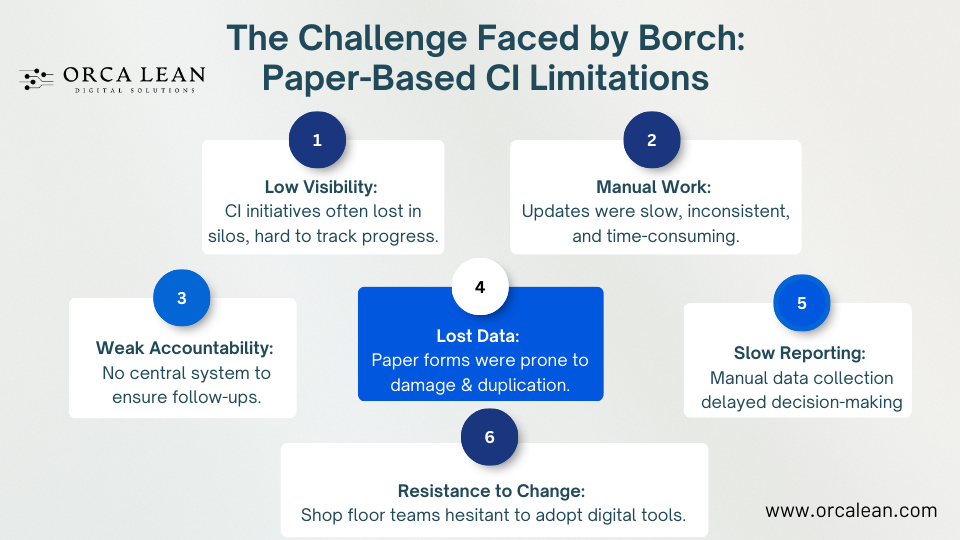Digitizing Continuous Improvement: Bosch's Journey to a Paper-Free Plant
March 24, 2025
Bosch has long been a global benchmark for operational excellence. Nestled in Portugal, this plant within Bosch's automotive electronics division has evolved through decades of Lean transformation. But in recent years, something critical has changed.
No longer content with incremental gains through Lean alone, Bosch took on the next frontier: digitizing Continuous Improvement (CI) as part of their Industry 4.0 vision.
This wasn’t about deploying shiny dashboards or experimenting with trendy tech. It was about turbocharging an already strong Lean engine—by using digital tools to multiply the speed, accuracy, and visibility of CI initiatives.
The Challenge: Paper-Based CI Limitations
Before digitization, Bosch's Continuous Improvement (CI) system operated through traditional, paper-based workflows. Improvement projects were initiated using printed forms, Gemba walk observations were handwritten, and Kaizen tracking relied on spreadsheets and whiteboards. While this structure provided a level of control, it introduced significant inefficiencies and hidden costs.

Some of the major challenges Bosch faced with paper-based CI tools included:
- Limited Traceability: Once an improvement initiative was submitted, it often disappeared into departmental silos. Tracking its progress or impact was cumbersome and inconsistent.
- Manual Updates: CI owners and team leads had to manually update the status of actions. This not only consumed time but often led to outdated or incomplete records.
- Accountability Gaps: Without centralized tracking, holding stakeholders accountable for follow-ups was difficult. Missed deadlines or unresolved issues became common.
- Data Loss and Redundancy: Paper forms could easily get misplaced or damaged. Additionally, the lack of a unified data repository meant duplication of efforts and an inability to analyze trends across teams.
- Inefficient Reporting: Generating reports or summaries for management involves manually collecting data from various sources, taking up hours that could be spent on actual problem-solving.
- Cultural Resistance: Introducing change in a traditionally manual environment brought its own hurdles. Many employees, especially on the shop floor, were hesitant to adopt digital tools, fearing complexity or loss of autonomy.
This status quo was misaligned with Bosch’s broader vision of lean, agile manufacturing. To remain competitive and future-ready, Bosch needed a way to eliminate these inefficiencies and build a more transparent, real-time, and engaging CI system.
Explore how Borch eliminate waste and improves operational efficiency. Read our detailed blog.
The Lean Foundation: A Maturity Curve
Bosch's digital journey didn’t emerge from a vacuum—it was the next logical step in a long-term CI maturity roadmap.
2000s: Lean Elements Phase
The journey began with isolated Lean tools. Teams deployed 5S, visual management, standard work, and simple problem-solving tools like the 5 Whys. These “Lean elements” helped instill a culture of discipline, structure, and early wins.
Mid-2000s: System Phase
These tools were then woven into a formal CI system. Standard operating procedures, CI boards, daily management systems, and KPI tracking brought greater consistency and cross-functional alignment.
2010s: Leadership-Driven Lean
Leadership began driving CI from the top. Plant managers, value stream owners, and department heads started living and breathing Lean. Improvement became strategic, with clear goals tied to productivity, quality, and cost.
Post-2019: The Turbocharged Phase
As Industry 4.0 matured, Bosch recognized that its Lean engine could be enhanced. Real-time data, digital workflows, and predictive analytics could eliminate remaining inefficiencies—if done right.
This mindset shift, from Lean alone to “Lean + Digital,” laid the foundation for a transformation that was both human-centric and tech-enabled.
Digital Transformation: A Strategic Shift
As Bosch entered the digital era, the leadership team made a conscious decision to avoid the pitfalls many manufacturers encounter: rolling out technology without purpose, overwhelmed by “shiny” dashboards and isolated pilots that don’t scale.
Instead, they adopted a reverse approach—starting with the business need, not the technology.
Start with Why: Defining the Business Value
Before choosing tools, Bosch asked critical questions:
- What inefficiencies still exist in our current CI process?
- Are we losing time due to manual data collection and reporting?
- Are improvement actions falling through the cracks because of limited visibility?
- How can digital tools empower—not replace—our workforce?
By mapping out these gaps, Bosch identified where digital could deliver the most impact. For instance:
- Automating follow-ups on Kaizen actions to improve accountability.
- Digitizing Gemba walk checklists to reduce paperwork.
- Enabling real-time visibility into PDCA cycles to drive faster decisions.

Formulating a Digital CI Roadmap
With clearly defined value cases, Bosch developed a structured roadmap for digital CI deployment. This roadmap focused on:
- Identifying quick wins with measurable ROI.
- Rolling out pilot projects in CI-mature departments.
- Scaling successful tools plant-wide using a standard playbook.
Crucially, the roadmap included checkpoints for training, user adoption, and KPI tracking—treating the digital transformation itself as a continuous improvement project.
Assembling a Digital-First Team
Bosch also built an Industry 4.0 team comprised of diverse roles:
- IT experts for technical implementation and integration.
- CI practitioners to preserve Lean discipline and focus.
- Value stream managers to ensure alignment with business goals.
This team ensured that technology remained a servant to strategy—not the other way around.
Digital transformation is never an easy task for any business, especially for manufacturing business where workers find it difficult to adapt with the changes. There are a few questions that every manufacturer asks themselves while thinking of digital transformation. Read our detailed blog to understand Transitioning from Paper to Digital in Manufacturing FAQs.
Bosch's Approach to Digital Transformation - From Paper to Digital
With clarity on purpose and a cross-functional team in place, Bosch began implementing its digital CI system. Their approach was methodical, iterative, and deeply anchored in Lean principles.
1. Digitizing Where It Matters Most
Bosch didn’t attempt to digitize everything at once. Instead, they prioritized high-impact processes:
- Gemba Walks: Transitioned from paper to mobile apps. Observations, photos, and actions could now be recorded in real-time and shared instantly.
- Kaizen Tracking: Manual Excel-based logs were replaced with digital boards that automatically updated statuses, deadlines, and responsible owners.
- PDCA Cycles: A3s were digitized to allow collaboration across departments, with each step timestamped and stored for future learning.
- Audits & 5S Reviews: Standard templates were uploaded into the system, enabling consistency across shifts and lines.
This targeted digitization created visible benefits quickly, building momentum for further change.
2. Cross-Functional Deployment
Digital CI was never positioned as an IT upgrade. It was owned by operations, co-created by users, and supported by IT. Key deployment strategies included:
- Piloting in controlled environments to minimize risk.
- Gathering frontline feedback to improve usability.
- Conducting hands-on training sessions to build confidence.
Teams weren’t just trained on how to use the tools—they were taught why the tools mattered.
3. Scaling with Discipline
Once the pilots proved successful, Bosch scaled up using a repeatable playbook:
- Rollout schedules were aligned with production planning.
- Local champions were nominated to support adoption.
- KPIs tracked engagement, issue resolution time, and idea submission rates.
The digital transformation became a cultural shift—not a one-off project.
Conclusion
Bosch’s digital CI journey proves that combining the discipline of Lean with the innovation of Industry 4.0 leads to real, measurable transformation. They didn’t abandon their Lean roots—they enhanced them. With strong leadership, a value-first strategy, and a people-centered approach, Bosch built a CI system that’s faster, smarter, and fully aligned with sustainability and business performance goals.
But most importantly, they did it by staying true to one core belief:
Lean is the engine. Digital is the turbocharger. People are the drivers.
If your organization is still relying on paper-based CI systems, disconnected tracking, or slow cycles of improvement, now is the time to act.
Solvonext was built for exactly this moment.
Designed for manufacturing environments and rooted in Lean principles, Solvonext helps you digitize your Continuous Improvement workflows—from Gemba walks and 5S audits to A3s and Kaizens—in one connected, easy-to-use platform. No fluff, just focused solutions that reduce waste, improve accountability, and accelerate impact.

Software Solutions for Manufacturing Excellence
Company
Social
Our Contact Info:
Email: contact@orcalean.com
Phone Number: 248 938 0375
Our Offices
